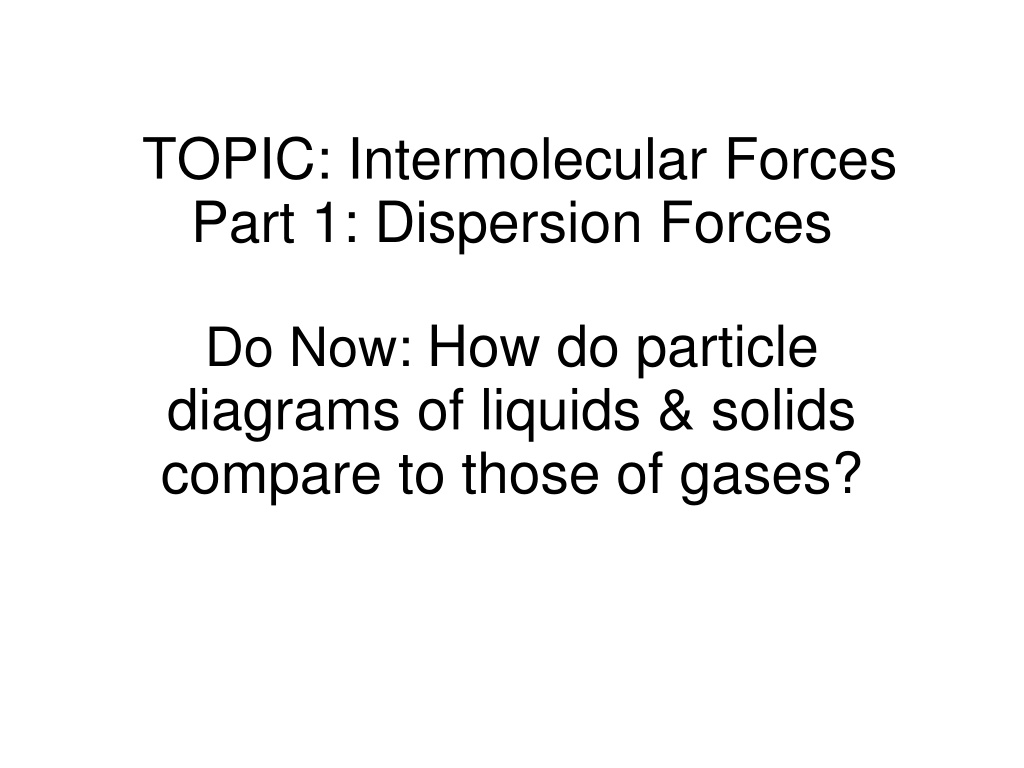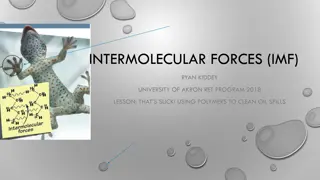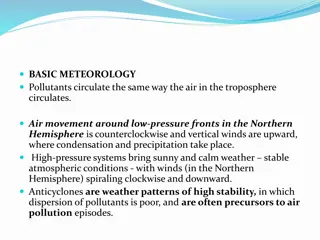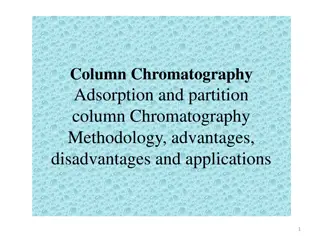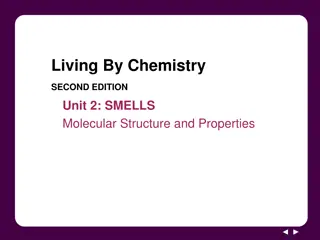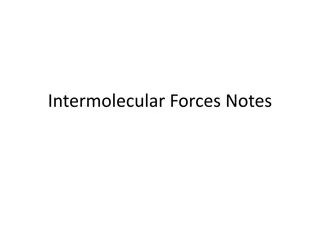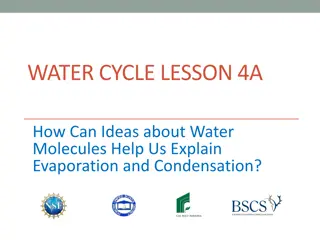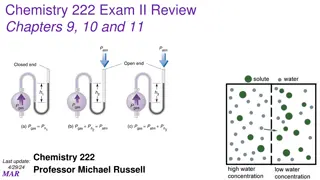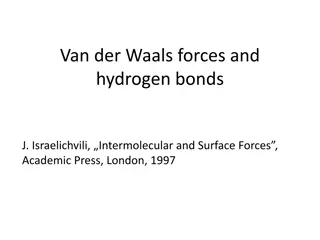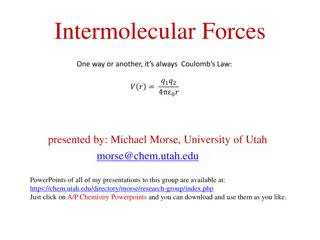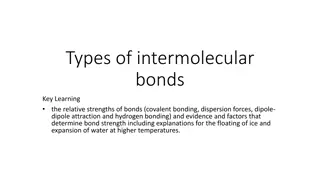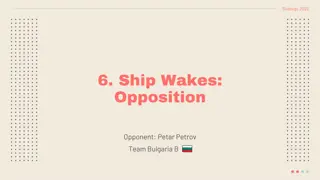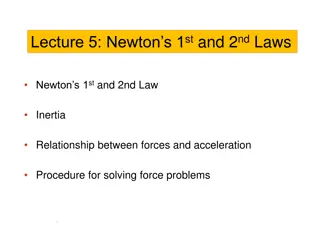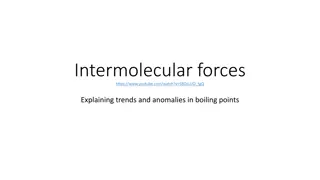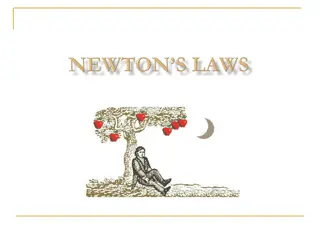Understanding Intermolecular Forces and Dispersion Forces in Molecules
Particle diagrams of liquids, solids, and gases reflect distinct arrangements due to intermolecular forces. The existence of substances as gases, liquids, or solids at room temperature is attributed to the forces between molecules known as intermolecular forces (IMF), with dispersion forces being the weakest type. These forces arise from the separation of charges and influence the behavior of nonpolar molecules through instantaneous fluctuations derived from electron motion. The categories of nonpolar molecules include noble gases, diatomic elements, hydrocarbons, and small symmetrical molecules.
Download Presentation

Please find below an Image/Link to download the presentation.
The content on the website is provided AS IS for your information and personal use only. It may not be sold, licensed, or shared on other websites without obtaining consent from the author. Download presentation by click this link. If you encounter any issues during the download, it is possible that the publisher has removed the file from their server.
E N D
Presentation Transcript
TOPIC: Intermolecular Forces Part 1: Dispersion Forces Do Now: How do particle diagrams of liquids & solids compare to those of gases?
SOLID LIQUID GAS
Why do some substances exist as gases, some as liquids, and some as solids at room temp?
Part of answer has to do with forces between separate molecules (called intermolecular forces)
Intermolecular forces between molecules. They are weaker. Intramolecular forces are between individual atoms (we will learn this later) Intermolecular forces Intramolecular forces
Intermolecular Forces=IMF Inter means between or among Intermolecular forces = forces between neighbouring compounds
***Separation of charge is responsible for the forces between the Molecules*** Most atoms don t have a charge, unless they are ions, so we often refer to them as having partial charges and write them like this
1. Dispersion Forces (van der waals): weakest IMF occur between nonpolar (symmetrical) molecules Nonpolar = no poles (no + or -) Can t tell one end of molecule from other end electrons are evenly distributed Click here for animation (slide 4 of 13)
instantaneous and momentary fluctuate results from motion of electrons if charge cloud not symmetrical will induce asymmetry in neighbor s charge cloud!
4 categories of Nonpolar Molecules - all these have DISPERSION FORCES (you need to memorize) Noble Gas group 18: He, Ne, Ar, Kr, Xe, Rn 7 diatomic elements H2, N2, O2, Cl2, F2, I2, Br2 Pure Hydrocarbons molecules with only C and H General formula CxHy : examples = CH4, C2H6, C3H8 these 3 small symmetrical molecule CO2, CF4, CCl4
Dispersion Forces and Size The larger the molecule, the great the Dispersion forces = stronger IMF B/c, the larger the electron cloud, the greater the fluctuations in charge Noble Gases: Rn has greater dispersion forces = strongest IMF Diatomic Elements: I2 is larger then F2, so I2 is larger (way more electrons) so greater dispersion forces, I2 is a solid at room temp. F2 is much smaller (less electrons) weaker dispersion forces, F2 is a gas at room temp.
You try Which has the greatest dispersion forces between it s molecules? C3H8 C8H18 CH4 C5H12 Which is most likely a liquid/solid (not a gas) at room temp? C3H8 C8H18 CH4 C5H12 Which is most likely a gas at room temp? C3H8 C8H18 CH4 C5H12
The weaker the IMF, the lower the boiling point (BP) Br2 = boils at 58.8 C, 137.8 F Compared to Water = boils at 100 C, 212 F So water must have stronger IMF
TOPIC: Intermolecular Forces Part 2: Dipole- Dipole and Hydrogen Bonding Do Now: List the 4 categories of Nonpolar Molecules all of these have DISPERSION FORCES Noble Gas group 18: He, Ne, Ar, Kr, Xe, Rn 7 diatomic elements H2, N2, O2, Cl2, F2, I2, Br2 Pure Hydrocarbons molecules with only C and H General formula CxHy : examples = CH4, C2H6, C3H8 these 3 small symmetrical molecule CO2, CF4, CCl4
All molecules have Dispersion forces (the regents calls these Van der Waals) 2 other types of forces (IMF): 1.Dipole-Dipole forces 2.Hydrogen bonds -if one of these are present, they are more important.
2. Dipole-dipole forces: Stronger then dispersion forces occur between polar (asymmetrical) molecules (they have a partial charge at each pole one is typically much larger than the other) Click here for animation (slide 3 of 13)
Dipole-dipole Forces & Polar Molecules Polar Molecule shows permanent separation of charge; has poles: one end partially (-) & one end partially (+); Asymmetrical
3. Hydrogen bonds: strongest IMF occur between molecules that have an : H-F H-O or H-N bonds ONLY Strongest Intermolecular Force Hydrogen Bonding Dipole-Dipole Dispersion
Hydrogen Bonding H-O N-H Occurs between molecules with H-F, H-O, or H-N bonds
Hydrogen Bonding Hydrogen bonding is extreme case of dipole-dipole bonding F, O, and N are all small and electronegative strong electrons attraction H has only 1 electron, so if being pulled away H proton is almost naked H end is always positive & F, O, or N end is always negative
Strength of Hydrogen Bonding Fluorine most electronegative element, so H-F bonds are most polar and exhibit strongest hydrogen bonding, so strongest IMF H-F is stronger than H-O which is stronger than H-N (H-bonding sound like FON to me!!!)
H O H H O H H-Bonding = strongest IMF much harder to pull molecules apart
H H H C H H C H H H Dispersion Forces= weakest IMF much easier to pull molecules apart
Hydrogen bonding: strongest IMF influences physical props a great deal H-F > H-O > H-N IMF vs Physical Properties If IMF then: Boiling point Melting point Heat of Fusion Heat of Vaporization while: Evaporation Rate Change from solid to liquid w/o changing temp Change from liquid to gas w/o changing temp Rate at which conc. will go from liquid to gas
Why do some substances exist as gases, some as liquids, and some as solids at room temp? #1 reason = IMF
If IMF are strong, substance will be solid or liquid at room temp Particles want to clump together If IMF are weak, substance will be gas at room temp Particles free to spread apart
Why do some substances exist as gases, some as liquids, and some as solids at room temp? #1 reason = IMF #2 reason = temperature (avg. KE)
Temp = average KE If we change T we change KE Increase KE will help pull molecules apart (overcome IMF)
Indicate type of IMF for each molecule: NH3 Ar N2 HCl HF Ne O2 HBr CH3NH2 Hydrogen bonding Dispersion forces Dispersion forces Dipole-dipole forces Hydrogen bonding Dispersion Dispersion Dipole-dipole Hydrogen bonding
